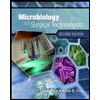
1.
To match:
Each of the following immune system complications with types of hypersensitivities.
Concept introduction:
The hypersensitivity is the body’s defense mechanism to an allergen, autoimmunity, and venom. The allergen can be of pollen, mold, and chemicals. The poison ivy, bee-stung injects venom into the body. There are totally four types of hypersensitivity depending upon the state of the allergen.
2.
Concept introduction:
The hypersensitivity is the body’s defense mechanism to an allergen, autoimmunity, and venom. The allergen can be of pollen, mold, and chemicals. The poison ivy, bee-stung injects venom into the body. There are totally four types of hypersensitivity depending upon the state of the allergen.
3.
Concept introduction:
The hypersensitivity is the body’s defense mechanism to an allergen, autoimmunity, and venom. The allergen can be of pollen, mold, and chemicals. The poison ivy, bee-stung injects venom into the body. There are totally four types of hypersensitivity depending upon the state of the allergen.
4.
Concept introduction:
The hypersensitivity is the body’s defense mechanism to an allergen, autoimmunity, and venom. The allergen can be of pollen, mold, and chemicals. The poison ivy, bee-stung injects venom into the body. There are totally four types of hypersensitivity depending upon the state of the allergen.
5.
Concept introduction:
The hypersensitivity is the body’s defense mechanism to an allergen, autoimmunity, and venom. The allergen can be of pollen, mold, and chemicals. The poison ivy, bee-stung injects venom into the body. There are totally four types of hypersensitivity depending upon the state of the allergen.
6.
Concept introduction:
The hypersensitivity is the body’s defense mechanism to an allergen, autoimmunity, and venom. The allergen can be of pollen, mold, and chemicals. The poison ivy, bee-stung injects venom into the body. There are totally four types of hypersensitivity depending upon the state of the allergen.
7.
Concept introduction:
The hypersensitivity is the body’s defense mechanism to an allergen, autoimmunity, and venom. The allergen can be of pollen, mold, and chemicals. The poison ivy, bee-stung injects venom into the body. There are totally four types of hypersensitivity depending upon the state of the allergen.
8.
Concept introduction:
The hypersensitivity is the body’s defense mechanism to an allergen, autoimmunity, and venom. The allergen can be of pollen, mold, and chemicals. The poison ivy, bee-stung injects venom into the body. There are totally four types of hypersensitivity depending upon the state of the allergen.
9.
Concept introduction:
The hypersensitivity is the body’s defense mechanism to an allergen, autoimmunity, and venom. The allergen can be of pollen, mold, and chemicals. The poison ivy, bee-stung injects venom into the body. There are totally four types of hypersensitivity depending upon the state of the allergen.
10.
Concept introduction:
The hypersensitivity is the body’s defense mechanism to an allergen, autoimmunity, and venom. The allergens can be of pollen, mold, and chemicals. The poison ivy, bee-stung injects venom into the body. There are totally four types of hypersensitivity depending upon the state of the allergen.
Want to see the full answer?
Check out a sample textbook solution
Chapter 18 Solutions
EBK MICROBIOLOGY:W/DISEASES BY BODY...-
- please fill in the empty sports, thank you!arrow_forwardIn one paragraph show how atoms and they're structure are related to the structure of dna and proteins. Talk about what atoms are. what they're made of, why chemical bonding is important to DNA?arrow_forwardWhat are the structure and properties of atoms and chemical bonds (especially how they relate to DNA and proteins).arrow_forward
- The Sentinel Cell: Nature’s Answer to Cancer?arrow_forwardMolecular Biology Question You are working to characterize a novel protein in mice. Analysis shows that high levels of the primary transcript that codes for this protein are found in tissue from the brain, muscle, liver, and pancreas. However, an antibody that recognizes the C-terminal portion of the protein indicates that the protein is present in brain, muscle, and liver, but not in the pancreas. What is the most likely explanation for this result?arrow_forwardMolecular Biology Explain/discuss how “slow stop” and “quick/fast stop” mutants wereused to identify different protein involved in DNA replication in E. coli.arrow_forward
- Molecular Biology Question A gene that codes for a protein was removed from a eukaryotic cell and inserted into a prokaryotic cell. Although the gene was successfully transcribed and translated, it produced a different protein than it produced in the eukaryotic cell. What is the most likely explanation?arrow_forwardMolecular Biology LIST three characteristics of origins of replicationarrow_forwardMolecular Biology Question Please help. Thank you For E coli DNA polymerase III, give the structure and function of the b-clamp sub-complex. Describe how the structure of this sub-complex is important for it’s function.arrow_forward
- Health Safety And Nutrition F/Young ChildHealth & NutritionISBN:9781305144767Author:MAROTZPublisher:Cengage
 Medical Terminology for Health Professions, Spira...Health & NutritionISBN:9781305634350Author:Ann Ehrlich, Carol L. Schroeder, Laura Ehrlich, Katrina A. SchroederPublisher:Cengage Learning
Medical Terminology for Health Professions, Spira...Health & NutritionISBN:9781305634350Author:Ann Ehrlich, Carol L. Schroeder, Laura Ehrlich, Katrina A. SchroederPublisher:Cengage Learning - Essentials of Pharmacology for Health ProfessionsNursingISBN:9781305441620Author:WOODROWPublisher:Cengage
 Biology (MindTap Course List)BiologyISBN:9781337392938Author:Eldra Solomon, Charles Martin, Diana W. Martin, Linda R. BergPublisher:Cengage Learning
Biology (MindTap Course List)BiologyISBN:9781337392938Author:Eldra Solomon, Charles Martin, Diana W. Martin, Linda R. BergPublisher:Cengage Learning Microbiology for Surgical Technologists (MindTap ...BiologyISBN:9781111306663Author:Margaret Rodriguez, Paul PricePublisher:Cengage Learning
Microbiology for Surgical Technologists (MindTap ...BiologyISBN:9781111306663Author:Margaret Rodriguez, Paul PricePublisher:Cengage Learning





